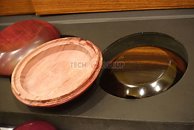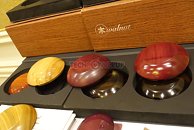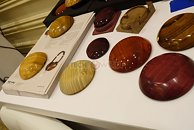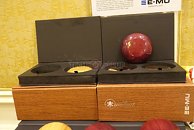Thursday, January 10th 2019

Creative E-MU Unveils Audiophile Headphones with User-replaceable Wood Enclosures
Creative's audiophile and studio brand E-MU unveiled two new around-the-ear monitors featuring user-replaceable wood enclosures. Headphones and monitors with wood enclosures are sought after for sounding more natural, with deeper lows and crisper mid-range; compared to most common headphones with ABS plastic enclosures. Among the two headphones launched are the heavier E-MU Teak and lightweight E-MU Walnut. The E-MU Teak features 50 mm neodynium drivers with bio-cellulose diaphragms, while the E-MU Walnut features smaller 40 mm drivers with the same quality of magnets and diaphragms as as the E-MU Teak.
The star attraction here is their enclosures, which are made of specialized single-origin woods - teak, walnut, rose, etc. The outer surface is polished for protection, while the inner one facing the driver is exposed. The enclosures ship in separate airtight, dehydrated jewel-cases. The E-MU Teak has an astounding frequency range of 5 Hz to 45 kHz, 106 dB sensitivity, and 25 Ω impedance. The E-MU Walnut, on the other hand, provides 10 Hz to 30 kHz frequency range, 103 dB sensitivity, and 30 Ω impedance. Both ship with 1.2-3 m long deoxygenated copper cables.
The star attraction here is their enclosures, which are made of specialized single-origin woods - teak, walnut, rose, etc. The outer surface is polished for protection, while the inner one facing the driver is exposed. The enclosures ship in separate airtight, dehydrated jewel-cases. The E-MU Teak has an astounding frequency range of 5 Hz to 45 kHz, 106 dB sensitivity, and 25 Ω impedance. The E-MU Walnut, on the other hand, provides 10 Hz to 30 kHz frequency range, 103 dB sensitivity, and 30 Ω impedance. Both ship with 1.2-3 m long deoxygenated copper cables.





14 Comments on Creative E-MU Unveils Audiophile Headphones with User-replaceable Wood Enclosures
... I should get into the "audiophile" business.
www.uitaudio.com/
www.wireworldcable.com/
robertsonaudiocables.com.au/
You will notice a trend here, look at the style of the writing. They all try to sound intelligent, when in fact they're all saying 'we have audio cables'. They're all objective, yet all sound unique, and somehow, they all still provide the best, 'true' audio experience. The only conclusion I can draw here is that they're actually just selling the same cable.
It gets even better when they try to add science in the mix
en.wikipedia.org/wiki/Audio_equipment_testing
There is a real group of listeners that believe in fairies and discredit double blind tests because they prove them wrong, every single time. This is easily the most gullible target audience you can find in tech, maybe fighting for the top spot with Apple fans.
At the end of the day, if a cable is a piece of uninterrupted copper, and it is physically capable of handling the currents and frequencies running through it, then I defy anyone to PROVE that one cable can sound better/different to another. It's the same snake oil tricks companies like Monster use to sell HDMI cables to morons. At the end of the day, a digital connection either works, or does not. Error checking and correction assure what goes in at one end, comes out of the other, or you simply get a black screen. The only difference cable quality can make, is in long cable runs, or in usage in places with crazy high levels of electrical or RF interference.
Listening to the teaks right now. It's based on the same Foster OEM design that everyone uses (see Massdrop TH-X00 or old school Denon D2/5/7k)
Also bio-cellulose isn't a plastic layer. That's the point of it being bio-cellulose. Its more akin to a pulp/paper driver in a speaker as opposed to a typical TPE driver.
Bacterial cellulose, Microbial cellulose are more "serious" name for it.
link.springer.com/article/10.1007/s13273-017-0028-3
onlinelibrary.wiley.com/doi/abs/10.1002/jbm.a.30570
I get that you could get mad at the marketing for dac and amps, but by saying that cellulose is plastic, you look just as bad as them for also saying non-sense. I mean since when a material can't have several application that are unrelated ? Silicon is one of the most confusing material, for having so many variants, that have completely different use.
Cables, Dacs and amp are the devil business, yes, but headphones don't have to suffer because of them.
Also, those cables you linked actually looked "reasonably" priced compared to some of the utter scams out there - let's not get into "cable risers", quartz discs and some of the other utter fairy dust nonsense. ;)